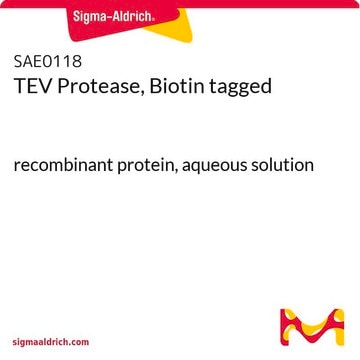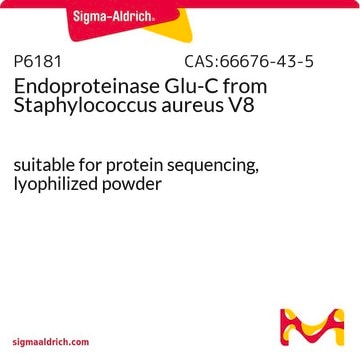SAE0110
HRV-3C Protease, Biotin tagged
Recombinant protein, 0.8-1.2 mg/mL, aqueous solution
Synonym(s):
Human Rhinovirus 3C Protease, Levlfqgp site protease, PreScission Protease
About This Item
Recommended Products
biological source
human (human Rhinovirus Type 14)
recombinant
expressed in E. coli
Assay
≥90%
form
aqueous solution
specific activity
≥5000 U/mg
mol wt
22 kDa
concentration
0.8-1.2 mg/mL
technique(s)
protein purification: suitable
suitability
suitable for protein modification
application(s)
life science and biopharma
shipped in
dry ice
storage temp.
−20°C
General description
This biotinylated HRV-3C protease is intended for on-column cleavage of fusion proteins with an HRV-3C cleavage site. It specifically cleaves the protein of interest from a column-bound fusion protein, leaving the fusion domain or tag bound to the affinity column (e.g. Ni-NTA column) and eluting only the protein of interest. This method is advantageous over post-elution cleavage for several reasons:
- It eliminates most impurities normally associated with purification on Ni-chelating columns.
- It allows gentler elution conditions, with added flexibility in the elution buffer composition. This can mitigate protein aggregation and inactivation.
After cleavage, the protease can be removed with any avidin-conjugated or streptavidin-conjugated beads. This product has been enzymatically biotinylated with no effect on its proteolytic activity. It has no additional protein purification tags. The product is supplied in aqueous buffer (0.8–1.2 mg/mL) with 20 mM Trizma®-HCl, pH 8.0, 200 mM NaCl, 1 mM TCEP, and 50% (v/v) glycerol.
Preparation Note
Legal Information
Storage Class Code
10 - Combustible liquids
WGK
WGK 2
Flash Point(F)
Not applicable
Flash Point(C)
Not applicable
Regulatory Listings
Regulatory Listings are mainly provided for chemical products. Only limited information can be provided here for non-chemical products. No entry means none of the components are listed. It is the user’s obligation to ensure the safe and legal use of the product.
JAN Code
SAE0110-VAR:
SAE0110-BULK:
SAE0110-0.5MG:
Certificates of Analysis (COA)
Search for Certificates of Analysis (COA) by entering the products Lot/Batch Number. Lot and Batch Numbers can be found on a product’s label following the words ‘Lot’ or ‘Batch’.
Already Own This Product?
Find documentation for the products that you have recently purchased in the Document Library.
Articles
Proteases for biotinylated tag removal for protein purification workflows with related reagents and technical resources.
Our team of scientists has experience in all areas of research including Life Science, Material Science, Chemical Synthesis, Chromatography, Analytical and many others.
Contact Technical Service








